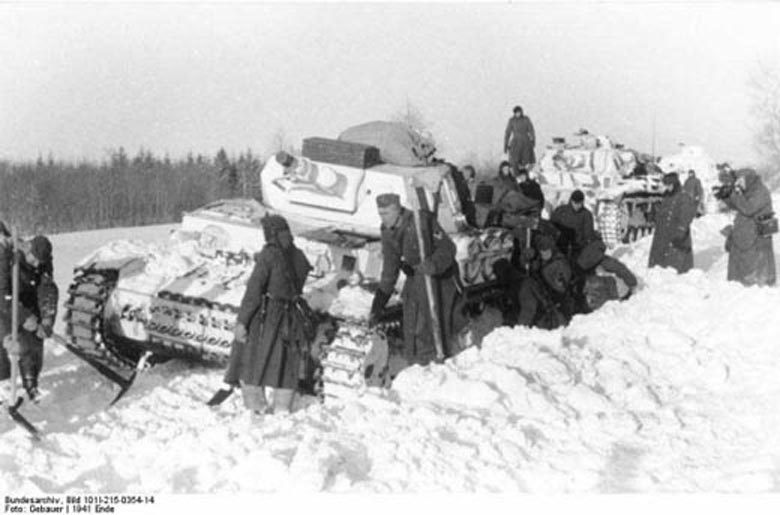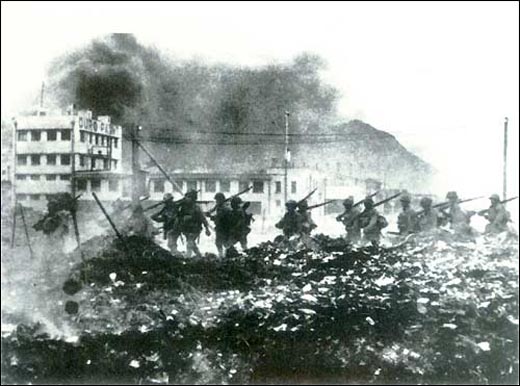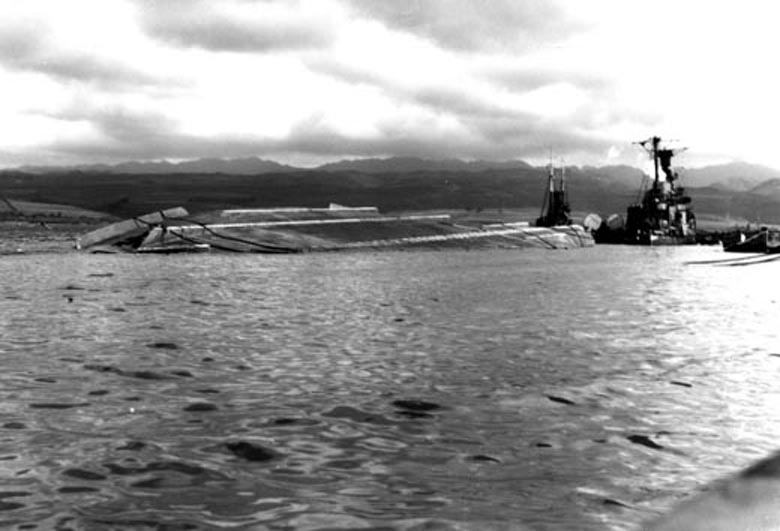Air Operations, CBI
The American-manned Nationalist Chinese Air Force American Volunteer Group (AVG, or “Flying Tigers”) makes its combat debut when a squadron supports a Royal Air Force (RAF) fighter sweep against Japanese army ground forces in Burma. The AVG P-40 fighters are based at the RAF's Rangoon/Mingaladon Airdrome.
[Air Operations, Pacific
A VMF-211 F4F pilot downs one of two H6K reconnaissance bombers that attack Wake Island from their base on Majuro Atoll in the Marshall Islands.
[Axis Diplomacy
Rumania and Hungary declare war on the US. These declarations are not accepted by the US Senate until June 5, 1942 and only then because of pressure from the Russians.
[Battle of the Atlantic
The British steamer Dromore Castle (5242t) sinks on a mine 20 miles south-southeast of Humber. The entire crew are rescued.
[Britain, Planning
Gen Auchinleck is told the forces intended for North Africa will be diverted to Asia.
[Burma
Small numbers of Japanese troops begin infiltrating into Burma from Thailand into the lower Tenasserim unopposed.
Gen Sir Archibald P. Wavel, CinC India, is given responsibility for Burma, previously within Air Chief Marshal Sir Robert Brooke-Popham's Far Eastern Command, and is promised reinforcements to strengthen the small garrison, fighting strength of which does not exceed 30 battalion during the campaign. Lt-Gen D. K. MacLeod's Burma Army, charged with protecting Burma Road and the Tenasserim airfields, is a heterogeneous group of Burmese, Indian and British forces, some poorly trained, formed into the Burma 1st Division (Burma 1st and 2nd Brigades and the Indian 13th Brigade) and the Indian 16th Brigade.
The 16 obsolete RAF fighters on hand are augmented by a squadron of the American Volunteer Group flown in to Mingaladon from an AVG base in China. The AVG Flying Tigers are commanded by Col Claire L. Chennault. Air strength is eventually increased but not enough to alter ground operations materially.
l#41121103">Diplomatic Relations
Slovakia declares war on the US and Britain. Washington never accepts this declaration nor when the Croats declare on the 14th.
Haiti, Honduras and Panama declare war on Germany and Italy.
[Eastern Front
Gen von Bock, commander of the German forces before Moscow, is replaced with Gen List upon Hitler's order.
Finnish forces complete the destruction of 2 Russian divisions south of Medvezhyegorsk in Soviet Karelia. From here on the Finns take on a defensive posture and effectively withdraw from the war. The campaign against Russia costs the Finns 25,000 dead and 50,000 wounded. Russia's losses are several times greater but Moscow never discloses the casualty figures.
NORTHERN SECTORThe 18th Army abandons its hard won territory east of the Volkhov, giving up all gains made during TYPHOON.
Panzers in the Snow |
 |
The 1st, 6th and 7th Panzer and 14th Motorized Divisions of the 3rd Panzer Group fight on the outskirts of Klin, while the 2nd Panzer Division holds open the road to the west. The 30th and 1st Shock Armies are closing in from the north and east. Army Group Center subordinates command of the 3rd Panzer to the equally hard pressed 4th Panzer Group. The 16th Army struggles to make any headway in the flooded Istra area. The 18th and 354th Rifle divisions attempt a crossing of the swollen Istra River but are held up by fierce German artillery fire. Rokossovsky redeploys his army into 2 groups, Groups Remizov and Katukov, to envelop the Istra reservoir from north and south. The 5th Army is to support the attack with its own 3-division mobile group.
The situation on the right flank continues to deteriorate as the 2nd Army is separated from the 2nd Panzer Army. Yefremov is evacuated as the 2nd Army falls back. To the left of the 2nd Army, the 2nd Panzer Army is forced away from the 4th Army to the north, leaving both flanks of the 2nd Panzer exposed.
Hitler blames the entire debacle in the center upon Field Marshal von Bock, dismissing him from command of Army Group Center. Field Marshal Kluge succeeds the ill Bock.
[Germany, Home Front
Hitler addresses about 50 leading Nazis in the Chancellery, telling them that the time has come to annihilate the Jews in Europe.
[Hong Kong
Japanese aircraft carry out heavy raids.
Japanese Occupy the Kowloon Peninsula |
 |
Malaya
Since the beginning of the invasion the Japanese have averaged about 120 bombing mission a day against Malaya. The airfield at Butterworth, in the northeast part of the peninsula, is evacuated. At George Town (Penang) 600 are dead and 1,110 wounded from the air raids. What few Allied aircraft that are left have been withdrawn to the south to protect the airfields, the harbor at Singapore and the Malayan capital of Kuala Lumpur.
Gen Percival decides to withdraw the Indian III Corps from Kelantan since the airfields there are already in possession of the Japanese. Movement of surplus supplies to the rear is begun. Troops fight delaying actions while awaiting rolling stock in which to withdraw. The Japanese penetrate the Jitra position and force the Indian 11th Division task force back to the Kedah River. Another Indian 11th Division force, called the Krohcol force, on the Kroh-Patani road, also falls back under pressure and at midnight passes to direct command of the corps. The Indian 12th Brigade Group is released from the corps reserve for action on the west coast.
[Pacific
- The Norwegian steamer Hydra II (1375t) is sunk by the American submarine S-38 mistaking it for a Japanese ship. 41 of her crew are lost; there are 9 survivors.
- The unarmed US freighter Lahaina (5645t), which was shelled and torpedoed by Japanese submarine I-9, sinks about 800 miles north of Hawaii.
- The Japanese armed merchant cruisers Hokoku Maru and Aikoko Maru capture the American steamer Vincent (6210t) below Pitcairn Island.
- The Dutch submarine K-12 sinks the Japanese steamer Toro Maru (1932t) off Kota Bharu, Malaysia.
Pearl Harbor Damage |
 |
Philippines
Japanese aircraft hit several places including airfields and Subic Bay, west of Manila. There are further Japanese air attacks on the few remaining US aircraft on the island.
The Japanese Kimura Detachment, 2,500 men of the 16th Infantry Division, lands in south Luzon at Legaspi unopposed. They secure Legaspi and the airfield. Maj-Gen George M. Parker, Jr., whose South Luzon Force consist of the 41st and 51st Division of the Philippine Army, sends elements of the 51st forward to delay the enemy, but contact is not made for several days. Taguegaro airfield falls to the Aparri force early in the morning.
[Turkey
The Struma, an old cattle boat build in 1867, leaves Romania for Palestine. On board are 769 Jews who have spent their savings to escape persecution. Their plan is to sail to Istanbul and there obtain immigration visas for Palestine.
At Istanbul the passengers were confined to the ship for 10 weeks, with the British refusing to accept the Jews into Palestine. The Turkish authorities also refused to transfer the Jews to a transit camp on land. Finally, on February 23, 1942, the Turkish police towed the ship into the open sea, although it had no water, food or fuel on board. Within a few hours it was sunk, struck by a torpedo apparently launched from a Soviet submarine. Only one person survived.
[United States, Home Front
French ships anchored in US ports are requisitioned by the authorities in Washington.
[